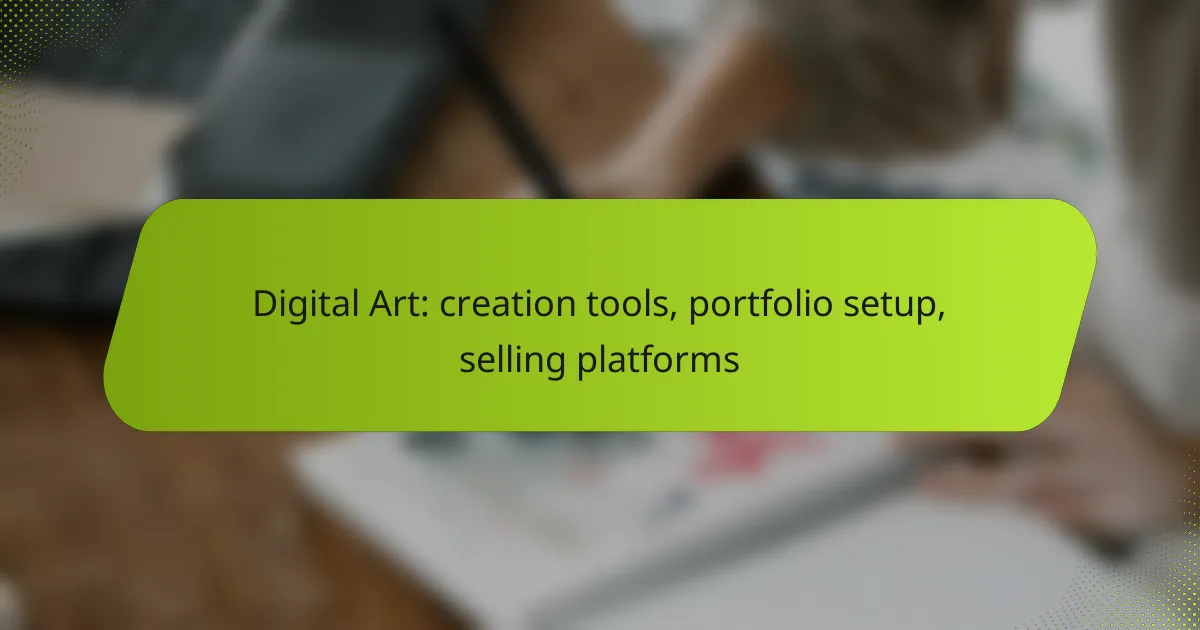Digital art has become increasingly popular, with a variety of creation tools available to suit different artistic styles and preferences. Setting up a compelling portfolio is crucial for showcasing your best work and attracting potential clients, while choosing the right selling platform can significantly impact your success in the market. Explore options like Adobe Photoshop and Etsy to enhance your artistic journey and reach a wider audience.

What are the best digital art creation tools?
The best digital art creation tools vary based on the artist’s needs, preferences, and the type of artwork they create. Popular options include Adobe Photoshop, Procreate, Corel Painter, Clip Studio Paint, and Affinity Designer, each offering unique features and capabilities tailored to different artistic styles.
Adobe Photoshop
Adobe Photoshop is a versatile tool widely used for digital painting, photo editing, and graphic design. It offers a comprehensive set of brushes, layers, and editing tools, making it suitable for both beginners and professionals.
Consider its subscription model, which may be a drawback for some users. However, the extensive community support and resources available can help you maximize its potential.
Procreate
Procreate is a popular app for iPad users, known for its intuitive interface and powerful features. It supports high-resolution canvases and offers a vast library of brushes, making it ideal for illustrators and concept artists.
Its one-time purchase price is appealing compared to subscription-based software, but it is limited to Apple devices. Users appreciate its responsiveness and the ability to create animations directly within the app.
Corel Painter
Corel Painter is designed specifically for digital painting, offering a wide range of realistic brushes and textures that mimic traditional media. It is favored by artists looking to replicate the look and feel of traditional painting techniques.
While it has a steeper learning curve, its depth of features allows for intricate artwork. Be prepared for a higher price point, but many find it worth the investment for serious digital painting.
Clip Studio Paint
Clip Studio Paint is particularly popular among comic and manga artists due to its specialized features for inking and panel layout. It combines raster and vector capabilities, allowing for flexibility in artwork creation.
Its pricing is competitive, and it often goes on sale, making it accessible for many artists. The software also includes animation features, which can be a bonus for those interested in motion graphics.
Affinity Designer
Affinity Designer is a cost-effective alternative to Adobe Illustrator, focusing on vector graphics. It offers a smooth workflow for creating illustrations, logos, and UI designs, making it suitable for both print and digital media.
The one-time purchase model is attractive, and its performance is optimized for both Mac and Windows. Users appreciate its user-friendly interface and robust features, though it may lack some advanced functionalities found in more established software.

How do I set up a digital art portfolio?
Setting up a digital art portfolio involves showcasing your best work in a way that is accessible and appealing to potential clients or employers. Focus on quality over quantity, and choose platforms that align with your artistic style and audience.
Using Behance
Behance is a popular platform for creatives to display their portfolios and connect with other artists. To set up your portfolio, create an account, and start uploading your projects, ensuring each piece is high-quality and well-presented.
Consider organizing your work into different projects, each with a clear description and tags to improve visibility. Engaging with the community by following other artists and commenting on their work can also help increase your exposure.
Creating a personal website
A personal website offers complete control over how your portfolio is presented. Use website builders like Wix, Squarespace, or WordPress to create a visually appealing site that reflects your artistic style.
Include an easy-to-navigate gallery, an about section, and contact information. Regularly update your site with new work and consider adding a blog to share insights about your creative process, which can attract more visitors.
Utilizing ArtStation
ArtStation is tailored specifically for artists and is widely recognized in the gaming and entertainment industries. Setting up a profile is straightforward; simply register and upload your artwork, making sure to include detailed descriptions and tags.
ArtStation allows you to showcase your work in various formats, including images, videos, and 3D models. Take advantage of the platform’s features, such as project breakdowns and the ability to sell prints, to enhance your portfolio’s appeal and reach.

What are the top platforms for selling digital art?
The leading platforms for selling digital art include Etsy, Redbubble, Society6, and Saatchi Art. Each platform offers unique features and caters to different audiences, making it essential for artists to choose one that aligns with their goals and style.
Etsy
Etsy is a popular marketplace for handmade and digital goods, allowing artists to set up their own shops. You can sell digital downloads, such as prints or design templates, directly to consumers. Consider the fees, which typically include listing fees and a percentage of sales, when pricing your work.
To succeed on Etsy, focus on high-quality images and detailed descriptions. Use relevant keywords to improve visibility in search results. Engaging with customers through personalized messages can also enhance your shop’s reputation.
Redbubble
Redbubble is a print-on-demand platform that enables artists to upload their designs and have them featured on various products, from apparel to home decor. This model allows you to earn royalties on each sale without managing inventory or shipping.
When using Redbubble, ensure your designs are optimized for different products. Explore promotional tools available on the platform, like social media sharing, to increase your visibility. Keep in mind that competition can be high, so unique and eye-catching designs are key.
Society6
Society6 focuses on high-quality art prints and home decor items, offering artists a platform to showcase their work in a curated environment. Artists earn a percentage of sales, and Society6 handles production and shipping.
To maximize your success on Society6, create a cohesive portfolio that reflects your style. Regularly update your offerings and promote your work through social media channels. Engaging with the community can also help you gain exposure.
Saatchi Art
Saatchi Art is an online gallery that connects artists with collectors, focusing on original artworks and limited edition prints. This platform is ideal for artists looking to sell high-value pieces and gain international exposure.
When listing your work on Saatchi Art, provide detailed descriptions and high-resolution images. Consider pricing your art competitively based on similar works. Participating in Saatchi Art’s exhibitions and promotions can further enhance your visibility and sales potential.

What criteria should I consider when choosing a selling platform?
When selecting a selling platform for digital art, consider factors like commission rates, audience reach, and ease of use. These criteria will significantly impact your profitability and visibility in the market.
Commission rates
Commission rates refer to the percentage of each sale that the platform retains. Typically, these rates can range from 5% to 30%, depending on the platform’s policies and services offered. Lower commission rates can maximize your earnings, but higher rates may come with additional marketing support.
Evaluate whether the platform’s commission structure aligns with your pricing strategy. For instance, if you plan to sell high-value pieces, a platform with a lower commission may be more advantageous.
Audience reach
Audience reach is crucial as it determines how many potential buyers will see your work. Platforms with larger user bases can provide greater exposure, increasing your chances of making sales. Research the demographics of each platform to ensure they align with your target audience.
Consider platforms that cater specifically to digital art or have a strong art community. Engaging with a platform that attracts art enthusiasts can lead to better sales opportunities.
Ease of use
Ease of use encompasses how user-friendly the platform is for both artists and buyers. A straightforward interface can make uploading artwork and managing sales more efficient. Look for platforms that offer intuitive navigation and clear instructions.
Additionally, consider the tools available for showcasing your art, such as customizable galleries or promotional features. A platform that simplifies these processes can save you time and enhance your selling experience.

